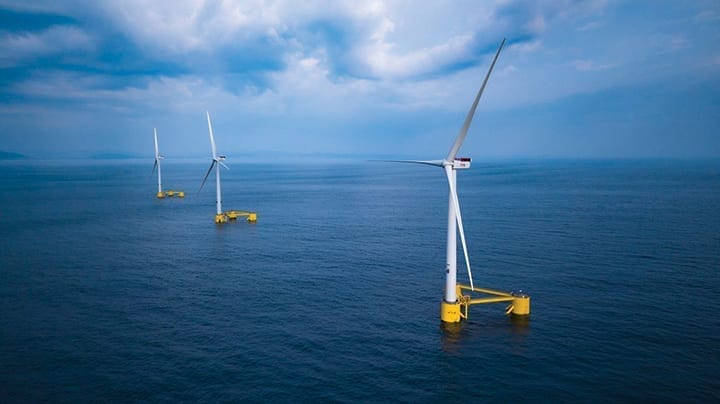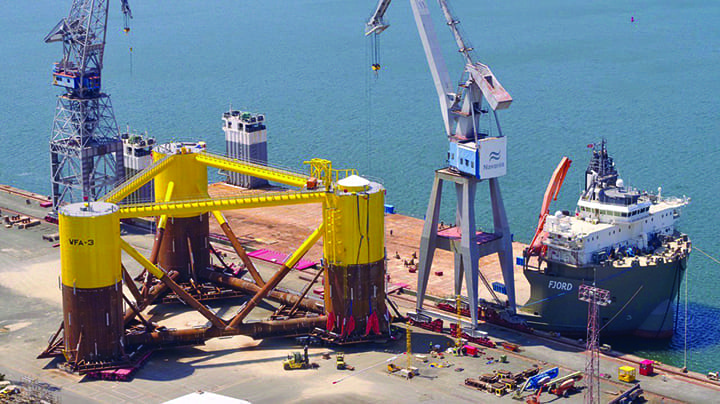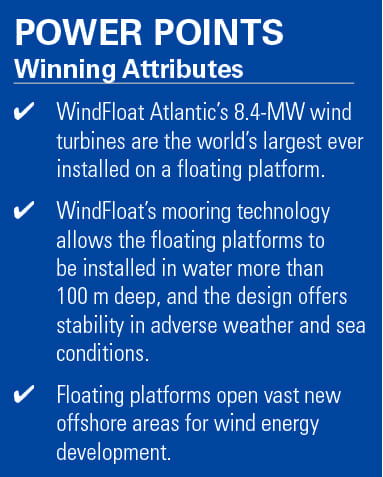Floating Platforms Are an Offshore Wind Gamechanger
The post Floating Platforms Are an Offshore Wind Gamechanger appeared first on POWER Magazine.


WindFloat Atlantic consists of three 8.4-MW wind turbines installed about 20 kilometers off the coast of Viana do Castelo, Portugal. Although its size is modest compared to other operating offshore wind farms, what makes the project special is its floating platforms. The design allows wind turbines to be constructed in previously inaccessible waters with depths of more than 100 meters.
Offshore wind farms are not a new thing. The first offshore wind farm, known as Vindeby, was constructed in 1991 in southeast Denmark near Lolland. It was a demonstration project to prove whether it was possible to generate wind power offshore. Spoiler alert: it is possible.
The Vindeby farm had 11 wind turbines with a total capacity of 5 MW and was constructed in water from 2 meters (m) to 5 m deep. Vindeby operated successfully for more than 25 years before being completely dismantled in 2017. Despite its small size, the Vindeby wind farm paved the way for offshore wind energy development. By the end of 2019, 29.1 GW of offshore wind capacity was installed worldwide, according to the Global Wind Energy Council. The International Renewable Energy Agency has predicted offshore wind capacity will reach 228 GW by 2030, and will be near 1,000 GW by 2050.
Wind turbines have come a long way since Vindeby was commissioned. On May 19, Siemens Gamesa Renewable Energy (SGRE) launched a 14-MW offshore direct-drive turbine with a 222-meter rotor. The company claims output for that turbine could reach up to 15 MW, using SGRE's Power Boost function. Other wind turbine suppliers aren't far behind. GE Renewable Energy began generating power from a 12-MW Haliade-X prototype at a site in Rotterdam, Netherlands, last November. MHI Vestas Offshore Wind, a joint venture between Vestas Wind Systems A/S (50%) and Mitsubishi Heavy Industries (50%), claims its V164-10.0 MW unit was the world's first commercial double-digit offshore wind turbine.
Offshore wind offers several advantages over land-based designs. Foremost among them are that offshore wind resources are more abundant, stronger, and blow more consistently than land-based wind resources. Many offshore wind turbines can't be seen from land, so people who feel wind turbines are an eyesore are less apt to object to their installation. Furthermore, offshore turbines don't tie up land that could otherwise be used for farming or other purposes. Marine ecosystems can even benefit from the structures, as they protect sea life by restricting access to certain waters and increasing artificial habitats.
Fixed-foundation offshore wind turbines are not routinely installed in waters deeper than about 50 m, but that is no longer a major stumbling block for future development. New floating designs have changed the landscape (or perhaps seascape is a better term) and opened up a whole new world of opportunity for the industry.
WindFloat Atlantic CommissionedOn July 27, Windplus-a consortium of EDP Renewables (54.4%), Engie (25%), Repsol (19.4%), and Principle Power Inc. (1.2%)-announced that WindFloat Atlantic was fully operational and supplying clean energy to Portugal's electrical grid. WindFloat Atlantic consists of three 8.4-MW MHI Vestas wind turbines providing a total capacity of about 25 MW. The turbines are the world's largest ever installed on a floating platform. To recognize this groundbreaking (or perhaps water-breaking is a better term) achievement, POWER has bestowed upon the project a Top Plant award in the Renewables category and congratulates all parties involved in its successful completion on a job well-done.
EDP Renewables said the WindFloat Atlantic project built on the success of the WindFloat1 prototype, which operated between 2011 and 2016. The 2-MW prototype successfully generated energy uninterruptedly for five years, according to the company, surviving extreme weather conditions completely unscathed, including waves up to 17 m and winds as high as 60 knots.
One of the three WindFloat Atlantic platforms was built at the Aviles and Ferrol shipyards in Spain (Figure 1), while the other two were manufactured at the Setubal shipyards in Portugal. The platforms have a height of 30 m and a distance between columns of 50 m. Dry-dock assembly provided significant logistical and financial savings, according to EDP Renewables. Once assembled, the platforms were towed to their permanent mooring sites using standard tug boats.
 |
1. The first WindFloat Atlantic platform was loaded out at Navantia's facilities in Fene, Spain. The floating platform, designed by Principle Power's engineering team, is a major achievement for the offshore wind industry. Courtesy: Principle Power Inc. |
WindFloat's mooring technology allows the platforms to be installed in water more than 100 m deep, and its design offers stability in adverse weather and sea conditions, as the prototype proved. The revolutionary design will allow much greater utilization of vast offshore wind resources. The consortium expects the successful installation and commissioning of WindFloat Atlantic to be a springboard for future offshore wind development. The group believes the model is replicable in other areas where adverse seabed conditions or significant water depth mean that traditional bottom-fixed offshore wind technology is not an option.
EDP Renewables said the project had abundant support from public and private institutions, which was a big reason why several leading companies decided to take part in the initiative. The Government of Portugal, European Commission, and the European Investment Bank all helped by providing financial support for the first-of-a-kind project. Other companies involved in the endeavor included the joint venture between Navantia/Windar, the A. Silva Matos Group, Vryhof, Bourbon Subsea Services, MHI Vestas, and dynamic cable supplier JDR Cables.
Construction began in October 2018. One of the main project milestones was the departure of the first floating structure from its assembly point in Ferrol in late summer 2019. The second platform left port in December 2019. In May 2020, the last of the three pre-assembled wind turbine platforms making up the project left the Port of Ferrol heading for its final destination 20 km off the coast of Portugal. WindFloat Atlantic became fully operational in July 2020.
Installing WindFloat AtlanticVryhof was responsible for delivering the complete mooring package. That includes project management services, controlling [the] supply chain, and interfacing between the certification authorities," Senol Ozmutlu, projects director with Vryhof, explained in the first video of a four-part series about the installation.
It's a challenging project because there's no other project as such that we could refer to," he said. But the team behind this project is very solution oriented and also extremely competent."
Bourbon was in charge of the procurement and installation of the mooring equipment, and the installation of the electrical cable on the floating wind turbine. In Part II of the video series, Helene Butat, Bourbon's operation manager, said, It's my job to get everybody's nose in the same direction."
Butat explained that because the project was a first-of-a-kind, new procedures had to be created for the job. It is a real advantage to have a good team. People you can trust. People you know their competence. You know what they are good at. It's essential."
In addition to providing its patented WindFloat technology solution, Principle Power was responsible for the full engineering and certification of the platform. It actively supported fabrication, installation, and commissioning of the three units, and will be responsible for operations and maintenance of the wind farm.
The big advantage of our floating technology is that we can use onshore techniques to install wind turbines, and then, later on, we can install the set offshore with the floater and the turbine ready to spin," Tiago Godinho, operation manager with Principle Power, said in the third video.

The COVID-19 pandemic caused some challenges during the final phases of installation, but the team overcame the obstacle. In the fourth episode of the video series, Butat said, All the personnel had to stay in quarantine for seven days before everybody could join the vessel." Once onboard, additional safety measures were reportedly put in place to protect personnel.
Butat said there were a lot of interface meetings between Bourbon, Principle Power, and Vryhof to develop the best process for installing the equipment. It is a little bit complex, because it's about the synchronization of several vessels, as well as subsea operations," she said.
Being first movers, of course, there's a risk," Jose Pinheiro, WindFloat Atlantic project director for EDP Renewables, said. This is [an] innovative project, so in that sense, there was always inherent risks to the deployment of this wind farm."
But everything came together in the end. To see the yellow pieces, the columns, the beams, and then the wind tower spinning-this is gorgeous," said Godinho.
[A] key advantage was the assembly technology used: dry-dock assembly provided significant logistical and financial savings, and the platforms were towed using standard tug boats," Pinheiro told POWER. The future potential of this technology for many places in the world-starting with almost the entire Iberian Peninsula-is huge."
From three floating platforms, we have 25 MW. Ten years ago, nobody would believe this can happen," Ozmutlu said. This project is definitely a game-changer."
-Aaron Larsonis POWER's executive editor.
The post Floating Platforms Are an Offshore Wind Gamechanger appeared first on POWER Magazine.